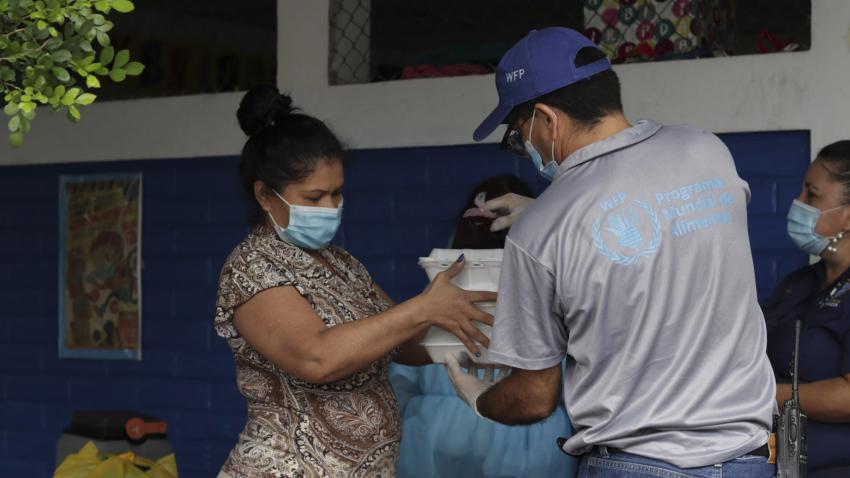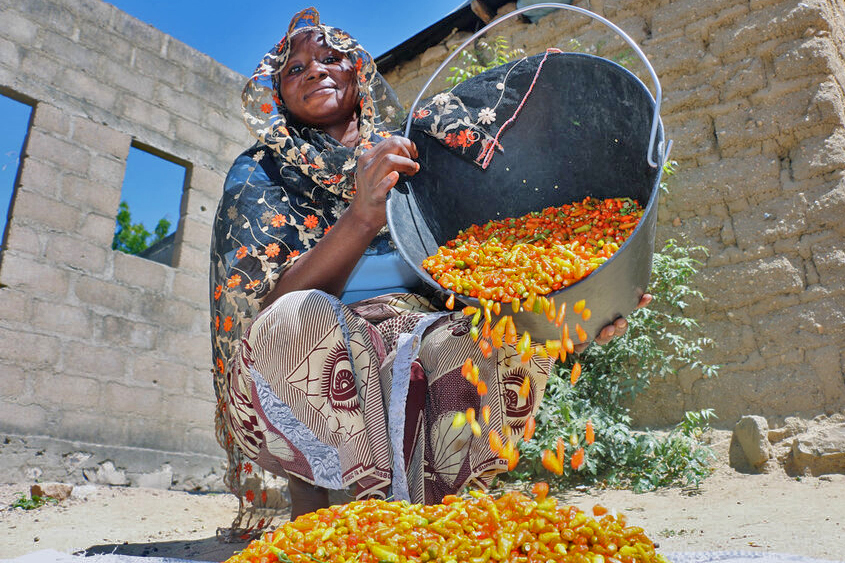A wake-up call to fight hunger
Even though today's global food production is enough to feed everyone on the planet, hunger continues to increase in some parts of the world. Despite some recent progress in reducing hunger in Asia and Latin America, the world is still facing food crises in many regions, especially in Africa, where the situation is dire.
The UN agencies that deal with food security use specific terms to describe the various levels of food scarcity using words such as hunger, food insecurity, and malnutrition. Let’s take a look at what they mean.
Explaining hunger and food insecurity
The Food and Agriculture Organization of the United Nations (FAO) describes hunger as an uncomfortable or painful physical sensation caused by insufficient consumption of dietary energy. This physical sensation may become chronic when the person does not consume a sufficient number of calories regularly to lead a normal, active and healthy life.
On the other hand, a person can fall into the food insecure category when there is a lack of regular access to enough safe and nutritious food for normal growth and development and an active and healthy life. This condition may be due to unavailability of food and/or lack of resources to obtain food. Food insecurity can be experienced at different levels of severity: mild, moderate or severe.
Malnutrition can be either undernutrition, or the other extreme – overweight and obesity. Both are worrying trends that coexist in the world today.
In children undernutrition can cause stunting and wasting. Stunting is insufficient height for a child’s age, while wasting is insufficient weight for the child’s height. Stunting is a measure of chronic nutritional deficiency, while wasting is a measure of acute nutritional deficiency.
What is the link between hunger and food insecurity?
When someone reaches a severely food insecure condition, it implies that has run out of food and gone a day or more without eating, explains the UN agency. Although severe food insecurity is at the end of the FAO scale, even moderate food insecurity is an alarming condition.
For those who are moderately food insecure, acquiring food is unpredictable. They might have to sacrifice other basic needs, just to be able to eat. When they do eat, it might be whatever is most readily available or cheapest, which might not be the most nutritious food.
The increase in obesity and other forms of malnutrition is partly due to this phenomenon, since highly processed foods are energy-dense, contain high saturated fats, sugars and salt, and are often cheaper and easier to get than fresh fruits and vegetables.
Eating highly processed foods may provide enough calories to meet daily requirements, but it can lead to a deficiency of essential nutrients that are required for the healthy functioning of the body. In addition to the stress caused by uncertain access to food, going through periods without eating can also lead to significant physiological changes.
FAO warns that children who experience hunger, food insecurity, and undernutrition are at a higher risk of developing chronic diseases such as obesity, diabetes, and other health problems later in life.
Food security and nutrition situation remains dire in 2022
The COVID-19 pandemic, conflicts, and weather shocks have led to an increase in the number of people facing hunger. According to the 2023 edition of the State of Food Security and Nutrition in the World report, between 691 and 783 million people faced hunger in 2022, representing an increase of 122 million people compared to 2019.
Apart from hunger, the report also highlights that 2.4 billion people experienced moderate or severe food insecurity and 900 million people faced severe food insecurity. Over 3.1 billion people could not afford a healthy diet. Many children under five suffer from malnutrition. Exclusive breastfeeding has improved, but more effort is needed to meet the malnutrition targets by 2030.
The rural-urban divide needs to be better understood
The assessment also emphasizes the impact of urbanization on agrifood systems, with almost seven in ten people projected to live in cities by 2050. Governments and policymakers must consider urbanization trends and their effects on food security, hunger, and malnutrition.
Although food insecurity affects more people in rural areas, consumption of highly processed foods is increasing in peri-urban and rural areas.
Children’s malnutrition also reveals urban and rural specificities: the prevalence of child stunting is higher in rural areas than in urban areas, as it is for wasting. At the same time, overweight is slightly more prevalent in urban areas compared to rural areas.
The Millennium Development Goals and food
In 2000, world leaders gathered at the United Nations to shape a broad vision to fight poverty, which was translated into eight Millennium Development Goals (MDGs). This remained, until 2015, the overarching development framework for the world. The global mobilization behind the Millennium Development Goals has produced the most successful anti-poverty movement in history. The MDG target of reducing by half the proportion of people living in extreme poverty was achieved in 2010, well ahead of the 2015 deadline. The proportion of undernourished people in the developing regions fell by almost half. However, a lot more work needs to be done. That work is now the focus of the Sustainable Development Goals.
The Sustainable Development Goals and food
Food is at the core of the Sustainable Development Goals (SDGs), the UN's development agenda for the 21st century. The second of the UN's 17 SDGs is to "End hunger, achieve food security and improved nutrition and promote sustainable agriculture." Achieving this goal by the target date of 2030 will require a profound change of the global food and agriculture system. Some of the components of this goal are:
- Ending hunger, and ensuring access by all people to safe, nutritious food;
- Ending all forms of malnutrition;
- Doubling the agricultural productivity and incomes of small-scale food producers;
- Ensuring sustainable food production systems;
- Increasing investment in agriculture;
- Correcting and preventing trade restrictions and distortions in world agricultural markets;
- Adopting measures to ensure the proper functioning of food commodity markets.
Facts and figures on Hunger and nutrition
- Global hunger remained relatively unchanged from 2021 to 2022, but is still far above pre-COVID-19-pandemic levels, affecting around 9.2 percent of the world population in 2022 compared with 7.9 percent in 2019.
- Nearly 600 million people are projected to be chronically undernourished by 2030. The pandemic and the war in Ukraine led to 119 million more people being undernourished than if neither had occurred
- A third of rural adults experienced moderate or severe food insecurity in 2022, compared to 28.8% in peri-urban and 26% in urban areas.
- The global gender gap in food insecurity decreased from 3.8 to 2.4 percentage points between 2021 and 2022.
- Urbanization challenges include the availability of unhealthy fast food, lack of fresh produce, exclusion of small farmers, and loss of natural capital due to urban expansion.
- In the 11 African countries studied, processed food consumption is higher in urban areas, but still prevalent in peri-urban and rural areas.
Zero Hunger Challenge
The United Nations Secretary-General launched the Zero Hunger Challenge in 2012 during the Rio+20 World Conference on Sustainable Development. The Zero Hunger Challenge was launched to inspire a global movement towards a world free from hunger within a generation. It calls for: Zero stunted children under the age of two 100% access to adequate food all year round All food systems are sustainable 100% increase in smallholder productivity and income Zero loss or waste of food.
Food Systems Summit
In 2021, UN Secretary-General António Guterres convened a Food Systems Summit as part of the Decade of Action to achieve the Sustainable Development Goals (SDGs) by 2030. The Summit launched bold new actions to deliver progress on all 17 SDGs, each of which relies to some degree on healthier, more sustainable and equitable food systems. Guided by five Action Tracks, the Summit brought together key players from the worlds of science, business, policy, healthcare and academia, as well as farmers, indigenous people, youth organizations, consumer groups, environmental activists, and other key stakeholders.
UN agencies working for food security
World Food Programme
The World Food Programme (WFP), aims to bring food assistance to more than 80 million people in 80 countries and is continually responding to emergencies. But WFP also works to help prevent hunger in the future. They do this through programmes that use food to build assets, spread knowledge and nurture stronger, more dynamic communities. This helps communities become more food secure.
World Bank
Investment in agriculture and rural development to boost food production and nutrition is a priority for the World Bank Group. The World Bank Group works with partners to improve food security and build a food system that can feed everyone, everywhere, every day. Activities include encouraging climate-smart farming techniques and restoring degraded farmland, breeding more resilient and nutritious crops and improving storage and supply chains for reducing food losses.
Food and Agriculture Organization of the United Nations
Achieving food security for all is at the heart of the efforts of the UN's Food and Agriculture Organization (FAO). Its main purpose is to make sure people have regular access to enough high-quality food to lead active, healthy lives. Its three main goals: the eradication of hunger, food insecurity and malnutrition; the elimination of poverty and the driving forward of economic and social progress for all; and, the sustainable management and utilization of natural resources, including land, water, air, climate and genetic resources for the benefit of present and future generations. FAO also issues the food price index, which is a measure of the monthly change in international prices of a basket of food commodities.
International Fund for Agricultural Development
The International Fund for Agricultural Development (IFAD) has focused exclusively on rural poverty reduction, working with poor rural populations in developing countries to eliminate poverty, hunger and malnutrition, raise their productivity and incomes, and improve the quality of their lives. All IFAD-funded programmes and projects address food and nutrition security in some way. IFAD has supported about 483 million poor rural people over the past four decades.
Resources
- UN Famine Prevention and Response Coordinator
- The State of Food Security and Nutrition in the World 2023
- Putting a number on hunger - Interactive Story
- Sustainable Development Goal 2: Zero Hunger
- OECD-FAO Agricultural Outlook 2019-2028
- The State of Food and Agriculture 2023
- WFP Hungermap
- High-Level Task Force on Global Food and Nutrition Security


